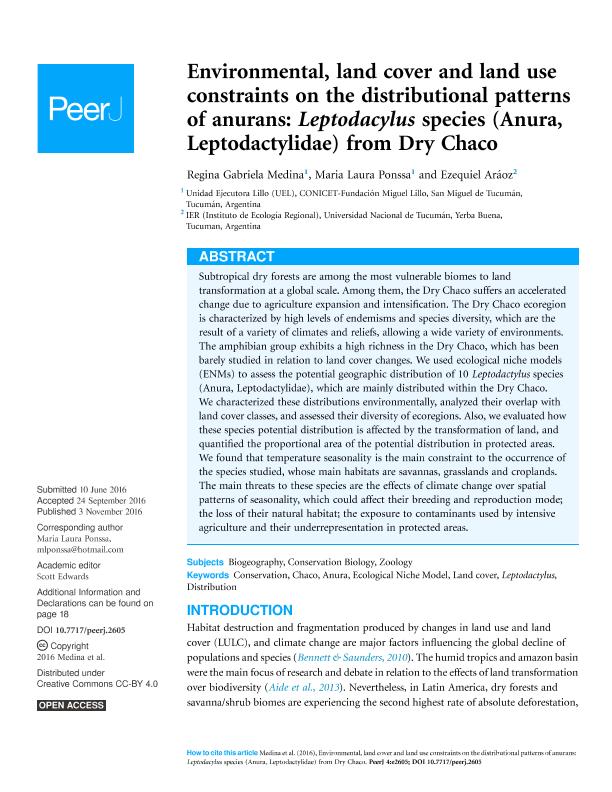Mostrar el registro sencillo del ítem
dc.contributor.author
Medina, Regina Gabriela

dc.contributor.author
Ponssa, María Laura

dc.contributor.author
Aráoz, Ezequiel

dc.date.available
2018-08-17T17:24:09Z
dc.date.issued
2016-11
dc.identifier.citation
Medina, Regina Gabriela; Ponssa, María Laura; Aráoz, Ezequiel; Environmental, land cover and land use constraints on the distributional patterns of anurans: Leptodacylus species (Anura, Leptodactylidae) from Dry Chaco; PeerJ Inc.; PeerJ; 2016; 11; 11-2016
dc.identifier.issn
2167-8359
dc.identifier.uri
http://hdl.handle.net/11336/56199
dc.description.abstract
Subtropical dry forests are among the most vulnerable biomes to land transformation at a global scale. Among them, the Dry Chaco suffers an accelerated change due to agriculture expansion and intensification. The Dry Chaco ecoregion is characterized by high levels of endemisms and species diversity, which are the result of a variety of climates and reliefs, allowing a wide variety of environments. The amphibian group exhibits a high richness in the Dry Chaco, which has been barely studied in relation to land cover changes. We used ecological niche models (ENMs) to assess the potential geographic distribution of 10 Leptodactylus species (Anura, Leptodactylidae), which are mainly distributed within the Dry Chaco. We characterized these distributions environmentally, analyzed their overlap with land cover classes, and assessed their diversity of ecoregions. Also, we evaluated how these species potential distribution is affected by the transformation of land, and quantified the proportional area of the potential distribution in protected areas. We found that temperature seasonality is the main constraint to the occurrence of the species studied, whose main habitats are savannas, grasslands and croplands. The main threats to these species are the effects of climate change over spatial patterns of seasonality, which could affect their breeding and reproduction mode; the loss of their natural habitat; the exposure to contaminants used by intensive agriculture and their underrepresentation in protected areas.
dc.format
application/pdf
dc.language.iso
eng
dc.publisher
PeerJ Inc.
dc.rights
info:eu-repo/semantics/openAccess
dc.rights.uri
https://creativecommons.org/licenses/by-nc-sa/2.5/ar/
dc.subject
Anura
dc.subject
Chaco
dc.subject
Conservation
dc.subject
Distribution
dc.subject
Ecological Niche Model
dc.subject
Land Cover
dc.subject
Leptodactylus
dc.subject.classification
Meteorología y Ciencias Atmosféricas

dc.subject.classification
Ciencias de la Tierra y relacionadas con el Medio Ambiente

dc.subject.classification
CIENCIAS NATURALES Y EXACTAS

dc.title
Environmental, land cover and land use constraints on the distributional patterns of anurans: Leptodacylus species (Anura, Leptodactylidae) from Dry Chaco
dc.type
info:eu-repo/semantics/article
dc.type
info:ar-repo/semantics/artículo
dc.type
info:eu-repo/semantics/publishedVersion
dc.date.updated
2018-08-15T14:20:36Z
dc.journal.volume
2016
dc.journal.number
11
dc.journal.pais
Estados Unidos

dc.journal.ciudad
Corte Madera
dc.description.fil
Fil: Medina, Regina Gabriela. Consejo Nacional de Investigaciones Científicas y Técnicas. Centro Científico Tecnológico - Tucumán. Unidad Ejecutora Lillo; Argentina
dc.description.fil
Fil: Ponssa, María Laura. Consejo Nacional de Investigaciones Científicas y Técnicas. Centro Científico Tecnológico - Tucumán. Unidad Ejecutora Lillo; Argentina
dc.description.fil
Fil: Aráoz, Ezequiel. Universidad Nacional de Tucumán. Instituto de Ecología Regional. Consejo Nacional de Investigaciones Científicas y Técnicas. Centro Científico Tecnológico Conicet - Tucumán. Instituto de Ecología Regional; Argentina
dc.journal.title
PeerJ
dc.relation.alternativeid
info:eu-repo/semantics/altIdentifier/doi/https://dx.doi.org/10.7717/peerj.2605
dc.relation.alternativeid
info:eu-repo/semantics/altIdentifier/url/https://peerj.com/articles/2605/
Archivos asociados
